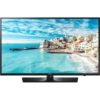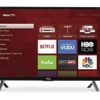Sharp 52″ Class Quattron Edgelit LED HDTV
- Edge-lit LED For 4,000,000 To 1 Dynamic Contrast
- AQUOS Net With Netflix And Customer Support Via Ethernet
- Inputs: 4 HDMI, 1 Component, 1 AV, 1 PC, No Analog Out
- Dimensions (WHD): 49-9/16″ X 33-55/64″ X 13-25/64″ In.
With the introduction of the LC-52LE810UN, Sharp® once again demonstrates its leadership in LCD and LED technology. In a monumental engineering breakthrough, Sharp’s proprietary Quad Pixel Technology, a 4-color filter that adds yellow to the traditional RGB, enables a vast array of colors to be displayed for the first time. The Sharp LC52LE810UN 52″Class Quattron Edgelit LED HDTV is fully featured, including the addition of Netflix streaming video capability through the AQUOS Net™ service, along with the industry’s leading online support system, AQUOS Advantage Livesm. A built-in media player allows for playback of music and photos via the USB port. Order the Sharp LC52LE810UN 52″Class Quattron Edgelit LED HDTV today!
List Price: $ 0.00
Price: $ 1,529.99
 LG Infinia 55LV5500 55-Inch 1080p 120 Hz LED HDTV with Smart TV
LG Infinia 55LV5500 55-Inch 1080p 120 Hz LED HDTV with Smart TVThe 55LV5500 delivers LED picture quality that along with a whole lot more. You can tap directly into instant entertainment with S…
 Samsung UN55D7000 55-Inch 1080p 240Hz 3D LED HDTV (Silver)
Samsung UN55D7000 55-Inch 1080p 240Hz 3D LED HDTV (Silver)Finally, entertainment and communication go hand in hand. The future of TV connectivity is calling, and the 55-inch Samsung UN55D7…
 VIZIO XVT3D554SV 55-inch 1080p 480Hz 3D LED HDTV with Full Array TruLED, Smart Dimming and VIZIO Internet Apps
VIZIO XVT3D554SV 55-inch 1080p 480Hz 3D LED HDTV with Full Array TruLED, Smart Dimming and VIZIO Internet AppsThe VIZIO Full Array TruLED LCD 3D HDTV with VIZIO Internet Apps brings cutting-edge, high-definition 3D technology to your home i…
 VideoSecu Low Profile TV Wall Mount for Most 32″ – 55″ Plasma, LCD, LED, HDTV Flat Panel TV, Universal Wall Mounts Bracket —Compatible with Sony Bravia, Samsung,LG, Haier, Panasonic, Vizio, Sharp AQUOS, Westinghouse, Pioneer, ProScan, RCA, Toshiba MF602B WA8
VideoSecu Low Profile TV Wall Mount for Most 32″ – 55″ Plasma, LCD, LED, HDTV Flat Panel TV, Universal Wall Mounts Bracket —Compatible with Sony Bravia, Samsung,LG, Haier, Panasonic, Vizio, Sharp AQUOS, Westinghouse, Pioneer, ProScan, RCA, Toshiba MF602B WA8Product description
The mount MF602B is compatible with LED, LCD, and Plasma TVs and other flat panel displays measuring between …













Comments
2 comments
Tech Guy “Tech Guy”
July 30, 2011
WOW,
I did a ton of research on all the reviews for this and other TV’s, which focused on the expert sites like AVS Forum. After all the research, I was actually a little hesitant on this purchase with the ‘Yellow’ being possibly a little bit of a marketing gimmick. However the plunge was made and ‘WOW’ at times it feels like a 3D TV and my wife still is amazed and she doesn’t get into technology. I would give this TV a Solid A+.
Was this review helpful to you?

|M.D.C. “The Franchise”
July 30, 2011
Sulu’s response to the picture is about accurate.,
I know some people have complained about this TV: oversaturated, inaccurate, unnatural, not realistic, etc. I think some people are missing the point after having viewed standard HD broadcasts and movies on HD CRT/LCD/Plasma displays of lesser quality than the LED types of TVs. Historically, when you think of a movie experience, you think of what you see in the movie theaters; thus, you expect your home display to give you the exact same picture quality. You’re definitely missing the point if you bought this TV expecting that. Here’s why.
Newer technology has included other buzzwords and terms to an already overpopulated field of various technology: 480p (DVD), 720p (lower end HD), 1080p (higher end HD), Composite (Red/White/Yellow, non-HD), Component (Red/Green/Blue, HD, but not all 1080p supported), HDMI (full HD, video and audio), optical, coax audio, etc etc etc. Tons of terms. And now, refresh rate…the latest thing to consider when buying a TV. The first thing to find out is whether you want the faster refresh rate or not. Most standard LCD and plasma TVs operate at 60Hz – which is the fastest rate the movie theater puts its picture out. What might surprise you is that when the movies are filmed, they are so at 120Hz which, when viewed, shows natural motion and minimal blur in regular scenes with people and vehicles. When you see scenes at 120Hz 1080p, there are times you feel like you’re standing there during the filming. Of course, this disconnects you from the “movie” experience somewhat, and I would submit that at first, it will feel unnatural. The slower speeds help to blur out judder during camera panning, which of course you will notice when watching at twice the speeds.
Sharp, in its infinite wisdom, has decided to also add another pixel to the spectrum of red/green/blue, which increases the color count of the image. This, coupled with the 1080p resolution and 120Hz, results in a clarity and picture quality unmatched by most other sets. The reason I gave you the full on back ground for 120Hz is so that you understand just why and where the yellow pixel comes into full play. In order to truly enjoy the benefit of the added pixel, you have to be open to a movie experience that is different from what you might see in the theater. That means deeper colors, more solid blacks, and a highly realistic experience, versus a “theater experience”. There definitely is a difference. Some will want one, some will want the other. If you are a theater type, you should skip this TV, and I promise that if you ignore that statement and buy the TV, you will be disappointed.
There are a number of presets on the TV, and then of course the custom options. I want to talk about three of the presets as I think some people don’t understand what they really are doing. If you reconcile with yourself what the preset is showing you, you might find certain ones giving the best overall quality for a “standing there” experience.
USER – This is basically your arena to customize your color, contrast, power, etc. Some people spend hours in this area trying to get their settings just right. In my humble opinion it is a waste of time. Why? Because no matter what setting you apply here, it will never be “true” or even “theater” quality. There’s a good reason for this which I will get into a little later, but again, some people are hell bent on trying to create their own custom calibration using DVDs and whatnot. If you’re that type of person then by all means, but I think it’s a waste.
DYNAMIC – Most TV sets that have dynamic as a setting are basically doing one thing – adjusting the contrast and brightness depending on the ambient lighting. That’s fine, but it creates an unnatural picture unless you’re in total brightness or total darkness. A movie such as Wanted that is majorly dark looks outstanding in bright daylight, not so hot in darkness. A movie like Day After Tomorrow that is in the daylight is the exact opposite. Then you talk about fine details which just don’t stand out in most cases. This setting is used best when you are looking at a movie with a lot of variances in the scenes – outdoors, darkness/space, indoor lighting, etc – and you want the TV to adjust the scene based on what your lighting level is. Some might like it, some might not.
DYNAMIC (FIXED) – in my opinion this is the star of the show. It does the same as DYNAMIC with one exception; it also analyzes the lighting of the specific scene to determine what the contrast and black levels should be. The reason I rate this so highly is simple: when watching a high definition movie or Blu-ray on this setting, what you see is basically the same as what you would see if you were standing on set. If they used certain types of lighting to show dusk or daylight or dawn, you can easily see these effects pronounced. The extra yellow pixel really does…
Read more
Was this review helpful to you?

|